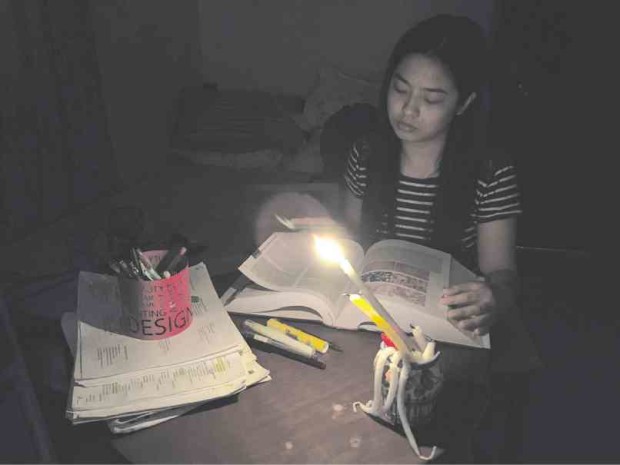Brownout economic cost: P400M a day

IGNORING the sweltering heat, a medical student reads her textbooks illuminated only by candlelight as Davao City goes through daily brownouts that now last five hours. KARLOS MANLUPIG/INQUIRER MINDANAO
DAVAO CITY—The economic cost to the city of power outages that would now last up to five hours could reach more than P400 million a day, according to a business industry leader here.
Joji Ilagan-Bian, one of the city’s top business leaders, said the city’s share in the annual P281.5 billion economic output of the entire Davao region, based on a 2014 report of the National Economic and Development Authority (Neda), is about P12.2 billion a month “or about P408 million a day.”
She said the city’s service sector (restaurants, offices, call centers, etc.) alone accounts for more than half of the city’s daily economic output and “you can imagine the extent of the damage.”
Bian rattled off the figures as the city’s main power distributor, Davao Light and Power Co. (DLPC) owned by the Aboitiz family, announced it is stretching daily rotating brownouts from two to five hours because of the worsening shortage of electricity in the entire Mindanao.
Deficit
Article continues after this advertisementThe shortage, DLPC said, has reached 100 megawatts a day. Every 20 MW of electric supply deficit translates to an hour of power interruption, DLPC said.
Article continues after this advertisementThe power firm said there would be two schedules of brownouts a day—four hours from 8 a.m. to 8 p.m. during so-called peak hours, and 7 a.m. to
8 a.m. and 8 p.m. to 12 midnight during so-called off peak periods.
It cited several reasons for the brownouts that included the “worsening effect of El Niño” and shutdown of one of several units of the Therma South Inc. (TSI) coal-fired power plant on April 6.
The TSI unit that was shut down is the one in Toril district here that was touted to be the answer to the city’s power shortage.
It had been commissioned late last year but has shut down more than twice since. The reasons for the shutdown ranged from maintenance to engineering problems even though the plant is still new.
Sister firms
Arturo Milan, DLPC president, said the shutdown decreased by half the amount of electricity that TSI delivers to DLPC. The two firms are sister companies.
Another DLPC sister company, Hedcor in Davao del Sur, now only delivers 22 MW instead of 49 MW that has been contracted to it, said Milan.
Milan said Mindanao’s two major sources of power—Agus and Pulangi hydropower plants—cannot be relied upon as the drought has drastically reduced their outputs to 108 MW out of a capacity of 982 MW.
He said the city’s power situation is not expected to improve unless repairs on TSI’s defective unit are completed by next week.
Bian said the city’s economy is expected to suffer heavily if the brownouts continued.
DLPC said it expects more electricity to be produced by another coal plant, owned by Alson’s Southern Philippines Power Corp. (SPPC), in May.
By that time, DLPC added, the generating capacity of hydropower plants that are still the major sources of power in Mindanao is expected to improve.
More coal
DLPC said it also contracted electric supply from a generating plant in Davao Occidental, also fueled by coal, owned by San Miguel Corp. but the plant is expected to start supplying power in August yet.
Digos City has not been spared from the brownouts with its lone power distributor, Davao del Sur Electric Cooperative (Dasureco), announcing two-hour daily power interruptions.
The estimated 60,000 consumers relying on Dasureco in Digos have been using modular generator sets that produce up to 16 MW of electricity.
But Godofredo Guya, Dasureco general manager, said the generator sets are running at full capacity already and demand continues to go up. Judy Quiros, Karlos Manlupig and Orlando Dinoy, Inquirer Mindanao